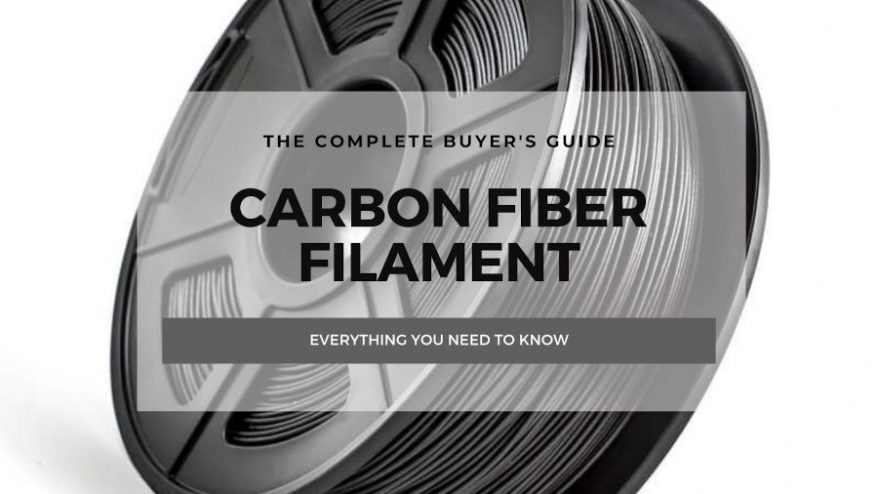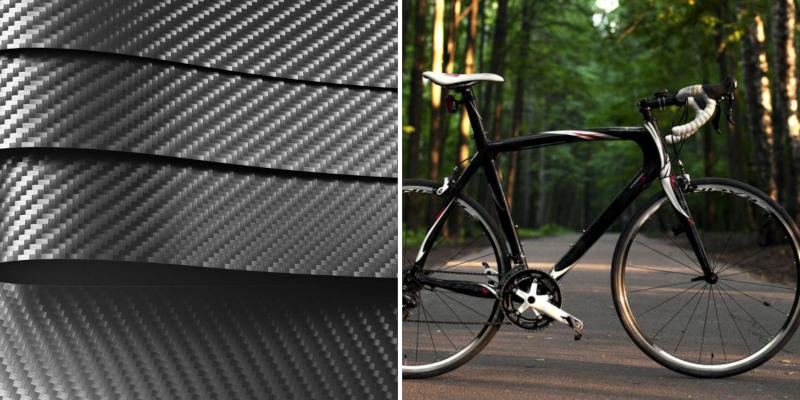
Carbon Fiber 3D Printing: The Complete Guide


At 3DSourced we’ve covered everything 3D printing and 3D since 2017. Our team has interviewed the most innovative 3D printing experts, tested and reviewed more than 20 of the most popular 3D printers and 3D scanners to give our honest recommendations, and written more than 500 3D printing guides over the last 5 years.
Extremely strong yet so light, carbon fiber 3D printer filaments are increasingly used to create high-quality prototypes. Carbon fiber filaments are usually infused into standard PLA or ABS filaments, but are also sometimes used in PETG, Nylon (also known as NylonX), and Polycarbonate PC filaments.
Carbon fiber is one of the most common composite filaments, along with kevlar and glass-infused filaments.
- We have an in-depth guide to all the major filaments in our 3D printer filament buyer’s guide.
Carbon fiber 3D printing: an introduction
Carbon fiber 3D printing filaments are made from tiny carbon fibers cut down small enough to fit in your 3D printer’s nozzle, and mixed with standard plastic filaments.
Also known as graphite fiber, most carbon fiber 3D printing uses FDM 3D printers or similar technologies to print tough parts, layer-by-layer, for industrial and prosumer uses.
However, some SLS 3D printers can print carbon-reinforced nylon powders.
History of Carbon Fiber
Carbon fibers were first produced by Joseph Swan back in 1860 for use in lightbulbs, then a technology in its infancy. Several years later in 1879, legendary inventor Thomas Edison baked and carbonized cotton threads, turning them into an all-carbon fiber filament to be used in one of the first ever electric-heated incandescent light bulbs.
More recently, carbon fiber’s first manufacturing uses began in the early 1960s, developed in Hampshire, UK, at the Royal Aircraft Establishment. Then process was patented by the UK’s Ministry of Defence and licensed to three companies, including Rolls-Royce.
Nowadays, carbon fiber is prized for potentially replacing heavier steel parts, as it is just as strong yet much lighter. Some predict future advances could make carbon fiber cars 50% lighter and 35% more fuel efficient — saving the average driver $5,000 over each car’s lifespan. Polyacrylonitrile (PAN) is used to make 90% of the world’s carbon fiber.

Carbon fiber 3D printing properties
To fit in your standard 0.4mm or larger nozzles, carbon fibers need to be cut into tiny strands, rather than using the continuous carbon strands used in other industries. Even then, they are far more likely to clog your nozzle than standard filaments — read on for our recommendations for dealing with clogging.
Not only is carbon fiber strong and light, it also has great heat resistance and dimensional stability. So much so, that it doesn’t shrink after cooling from printing, making for accurate and crisp finished prints.
Carbon fiber 3D printer settings and melting point
Despite carbon fiber’s heat resistance and strength, it shouldn’t change how you print. If printing a PLA carbon fiber filament, you can usually use similar print settings as for standard PLA. The same goes for ABS carbon fiber filaments.
However, as a composite and abrasive filament, carbon fiber filaments will destroy your standard brass nozzles. The carbon fibers are tougher than the brass, and will decimate it in no time at all. Therefore, for carbon fiber 3D printing, you’ll need either a hardened steel nozzle, or even a ruby-tipped nozzle.
- We have a full buyer’s guide for 3D printer nozzles.

Hardened steel nozzles tend to be less thermally conductive than brass nozzles, so you will need to increase printing temperature to achieve the same results. If you usually print PLA at 190°C, go for 220-230°C for a carbon fiber mix. This however depends on the type of filament you use — check your brand for specific details.
If your base filament needs a heated bed and a heated chamber, like ABS or Nylon, then you’ll definitely still need one. However, for optional filaments like PLA you can go without — we still recommend using one though.
How much do carbon fiber filaments cost?
Costs vary based on the material the carbon fibers are mixed with. PLA carbon fiber filament mixes will generally be cheaper than industrial PEI mixes. Starting costs are around $40 per 0.5kg spool, with NylonX costing slightly more.
Carbon fiber composites are slightly cheaper than glass-infused filaments.
Best Carbon Fiber Filaments
Some PLA filaments we recommend include:
Best carbon fiber 3D printers
The quality of 3D printer you decide to purchase will greatly affect your print quality and results — and this only becomes more noticeable with more difficult filaments. As an abrasive filament and a composite, carbon fiber-filled filaments are best printed on higher quality machines.
This doesn’t mean you have to use a $50,000+ industrial 3D printer, and in fact some people have gotten good results from budget 3D printers, but nevertheless here are some carbon fiber 3D printers we recommend:
| Name/Brand | Build Volume (mm) | Price | Where to buy? |
|---|---|---|---|
| Pulse XE | 250 x 220 x 215 | $999 | Matterhackers here |
| Ultimaker S3 | 230 x 190 x 200 | $3,850 | Dynamism here |
| Raise3D Pro2 | 305 x 305 x 300 | $3,999 | Dynamism here |
| Makerbot Method Carbon Fiber Edition | 190 x 190 x 196 | $3,499 | Dynamism here |
| XYZprinting PartPro300 xT | 295 x 300 x 300 | $5,500 | Dynamism here |
| Ultimaker S5 | 330 x 240 x 300 | $5,995 | Dynamism here |
Carbon fiber 3D printing: Pros & Cons
Advantages of carbon fiber 3D printing
- Very strong: one of the toughest materials around, increasing the strength of any filament it is mixed with.
- Very good dimensional stability: does not shrink when cooling.
- Lightweight: as strong as steel, yet at only a fraction of the weight.
- Heat resistance: carbon fiber doesn’t melt until over 3600°C, with the exact numbers not completely known. Therefore, carbon fiber 3D printed parts can handle high heats with no problem.

Disadvantages of carbon fiber filament
- Abrasive: the carbon fibers chew through brass nozzles and require hardened steel nozzles to print consistently.
- Oozing problems: carbon fiber 3D printer filaments can ooze, requiring optimization of your 3D slicer retraction settings.
- Clogs more often: the carbon fibers can clog smaller nozzles, even standard 0.4mm ones. Therefore, it is strongly recommended to go with a larger 0.5mm+ nozzle size, or face constantly unclogging your printer.
- Potentially more brittle: carbon fiber’s strength and rigidity can make filaments more brittle. For filaments like PLA that are already known for being somewhat brittle, this can create problems for parts that need to withstand strong forces or impacts.
Carbon fiber 3D printing tips
- Retraction settings: reduce to almost zero to minimize oozing and stringing.
- Use a larger nozzle: standard 0.4mm nozzles can often clog due to the carbon fibers. Use 0.5mm+ size nozzles for more reliable and consistent printing.
- Slower printing speed: with more complex filaments, consider running slightly slower than you would with PLA or ABS. Failed or imperfect prints can be costly mistakes, and slower print speeds make for more reliable printing.
How to store carbon fiber filaments
Some filaments are more hygroscopic than others, but most need to be stored carefully, preferably in airtight containers to stop them getting “wet.”
Storage importance depends on your mix. Notoriously hygroscopic filaments like Nylon carbon fiber filaments will require careful airtight storage, whereas PLA, though hygroscopic, will not immediately ruin. If your filament gets wet, you can dry it in a filament dryer.
We recommend the following filament storage containers and dryers:
Carbon Fiber Applications
Within 3D printing, carbon fiber filaments are used in rapid prototyping, to print intricate and strong RC vehicle parts, 3D printed drone parts, and is used in the automotive, aerospace and engineering industries. It’s also increasingly used in boats and wind turbine blades.
Outside of 3D printing, carbon fiber is increasingly used in racing cars, has a variety of military applications, and in sports equipment like tennis rackets, golf clubs, bicycle frames, and more.




















